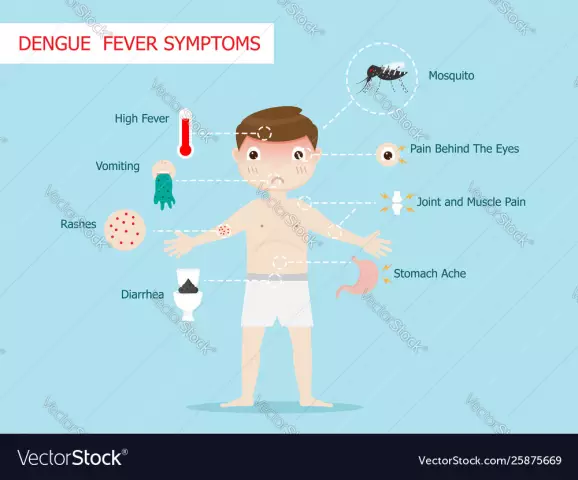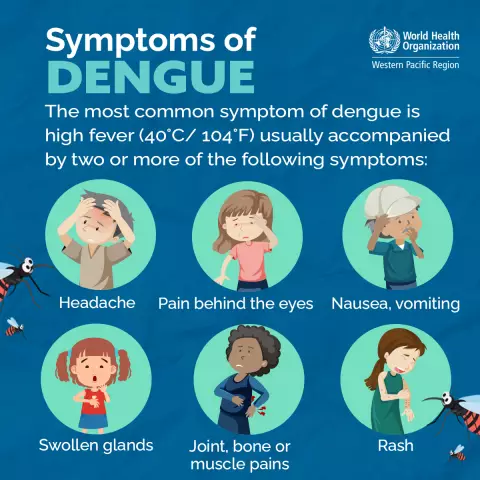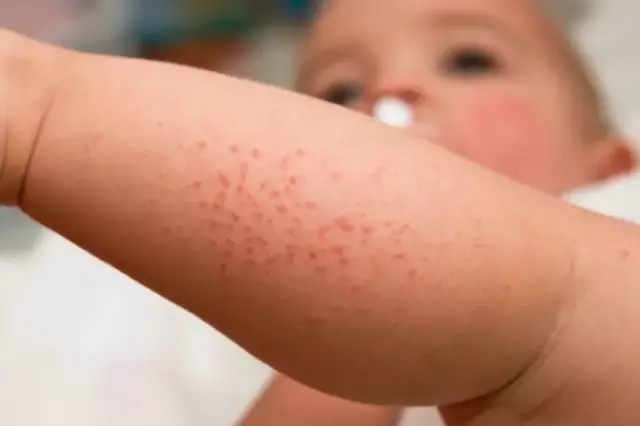- Author Rachel Wainwright [email protected].
- Public 2023-12-15 07:39.
- Last modified 2025-11-02 20:14.
Hemorrhagic fever

The term "hemorrhagic fever" includes a group of infectious diseases, which result in toxic damage to the walls of blood vessels and the development of hemorrhagic syndrome. The disease is characterized by general intoxication of the body and the development of multiple organ pathologies. Let's take a closer look at the main symptoms, treatment, and prevention of hemorrhagic fever.
Causes of hemorrhagic fevers
The following viruses cause the disease: Filoviridae, Arenaviridae, Bunyaviridae, Togaviridae. All these viruses have one thing in common - the relationship to the cells of the human vascular endothelium. These viruses are carried by ticks and mosquitoes. Some types of hemorrhagic fever are transmitted by food, household contact and waterways.
A person has a fairly high susceptibility to hemorrhagic fevers. Persons whose professional activity is associated with constant contact with wildlife are especially susceptible to the disease.
The mechanism of damage in hemorrhagic fevers
- vascular damage by a virus or a product of its exchange;
- inflammation and violation of the integrity of the walls of blood vessels, the release of biologically active substances into the lumen;
- the development of disseminated intravascular coagulation due to a deficiency of bleeding (simultaneous coagulation of blood in some vessels and low coagulation in others).
All these symptoms of hemorrhagic fevers cause a lack of oxygen in the tissues (hypoxia), there is a malfunction of the heart, brain, kidneys, lungs and a significant loss of blood.
The severity of the disease depends on its type, as well as on the characteristics of the human body and the degree of activity of its immunity. Mostly hemorrhagic fevers result in complete recovery, but deaths also occur.
Symptoms of hemorrhagic fever
In most cases, all types of hemorrhagic fevers have a similar course. The incubation period is 1-3 weeks, followed by an initial period (2-7 days), a peak period (up to 2 weeks) and a convalescence period (up to several weeks).
At the initial stage of the disease, intoxication of the body and fever are observed, which is accompanied by hallucinations, delirium and loss of consciousness. Against the background of general intoxication, toxic hemorrhage is a characteristic symptom of hemorrhagic fever. Violation of the heart rhythm and a decrease in blood pressure are noted. A general blood test indicates leukopenia and increasing thrombocytopenia.
Immediately before the onset of the peak period, the patient's condition is briefly normalized, after which an increase in toxicosis occurs, hemodynamics is disturbed, and multiple organ disorders occur. During the period of convalescence, there is a gradual abatement of the symptoms of hemorrhagic fever and the restoration of the normal state of the body systems.
Hemorrhagic fever contributes to the development of severe complications that often threaten the patient's life: coma, acute renal failure, infectious toxic shock.
Diagnosis of hemorrhagic fevers
The basis for the diagnosis of hemorrhagic fevers is the data of the epidemiological analysis and the clinical picture. Specific diagnostics is carried out using the following methods:
- enzyme immunoassay (ELISA);
- serological studies (RNIF, RSK);
- virological method;
- detection of viral antigens (PCR).

The main feature of hemorrhagic fevers is thrombocytopenia and the presence of red blood cells in feces and urine, as well as the presence of symptoms of anemia. Bleeding along the gastrointestinal tract is evidenced by a positive fecal occult blood test.
The main symptoms of hemorrhagic fever with renal syndrome are aneosinophilia, leukopenia, and an increased content of stab neutrophils. In the urine, protein and casts are noted, and residual nitrogen is observed in the blood.
Hemorrhagic fever treatment
For any type of hemorrhagic fever, the patient must be urgently hospitalized. In the treatment of fever, the patient is prescribed strict bed rest. You should eat easily digestible semi-liquid and high-calorie dishes, maximally saturated with vitamins: fruit and berry juices, vegetable broths, fruit drinks, rosehip infusions. Vitamin therapy is mandatory. Vicasol (vitamin K) must be taken for four days.
In addition, an intravenous glucose solution is prescribed, and small amounts of blood may be transfused during fever. If necessary, prescribe iron, campolon and antianemin preparations. The complex treatment also includes antihistamines. The patient is discharged from the hospital only after final recovery, after which he is observed for some time on an outpatient basis.
Prevention of hemorrhagic fever
First of all, for the prevention of hemorrhagic fevers, it is necessary to take measures aimed at destroying the vectors of infection and preventing bites. For this, in places of natural distribution, a thorough cleaning of the areas prepared for the settlement is carried out from ticks and mosquitoes.
In places where the epidemic is especially widespread, it is recommended to wear tight clothing, gloves, boots, as well as special antimicrobial masks and overalls. It is recommended to use repellents in woodlands.
Some types of hemorrhagic fevers are vaccinated.
YouTube video related to the article:
The information is generalized and provided for informational purposes only. At the first sign of illness, see your doctor. Self-medication is hazardous to health!






